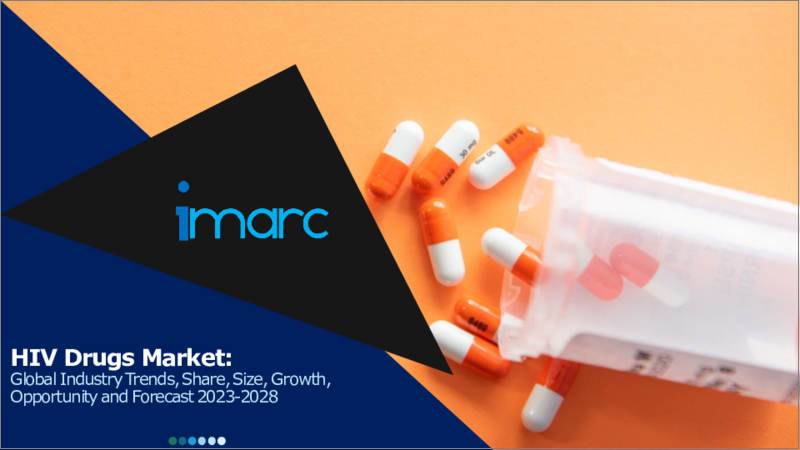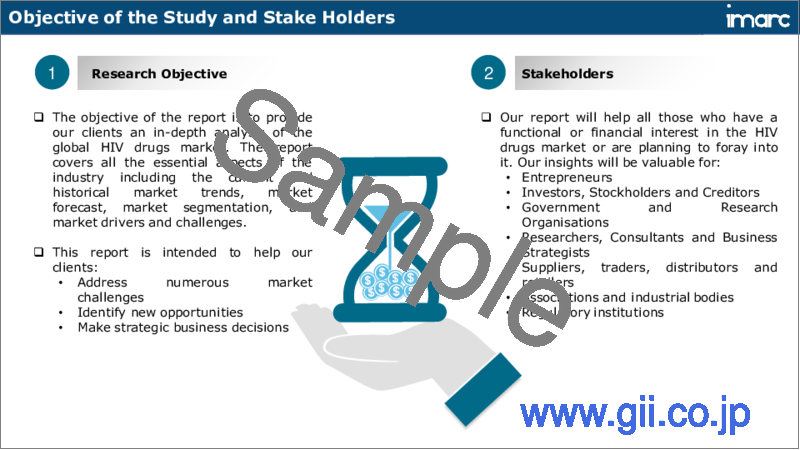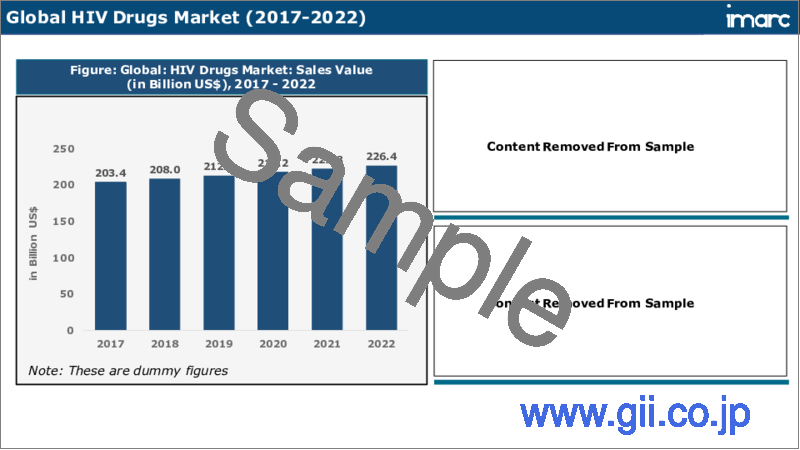|
|
市場調査レポート
商品コード
1347373
HIV治療薬市場:世界の産業動向、シェア、規模、成長、機会、2023-2028年予測HIV Drugs Market: Global Industry Trends, Share, Size, Growth, Opportunity and Forecast 2023-2028 |
||||||
|
● お客様のご希望に応じて、既存データの加工や未掲載情報(例:国別セグメント)の追加などの対応が可能です。 詳細はお問い合わせください。 |
|||||||
| HIV治療薬市場:世界の産業動向、シェア、規模、成長、機会、2023-2028年予測 |
|
出版日: 2023年09月04日
発行: IMARC
ページ情報: 英文 145 Pages
納期: 2~3営業日
|
- 全表示
- 概要
- 図表
- 目次
市場概要:
世界のHIV治療薬の市場規模は2022年に305億米ドルに達しました。今後、IMARC Groupは、2023年から2028年にかけて3.95%の成長率(CAGR)を示し、2028年までに388億米ドルに達すると予測しています。
ヒト免疫不全ウイルス(HIV)は、血液や性的接触を通じて人から人へ感染する、慢性的で生命を脅かす病気です。HIVは、CD-4細胞として知られる免疫細胞を攻撃するウイルスであり、身体を感染症や他の病気にかかりやすくします。長年にわたり、世界のHIV感染症の増加は、HIV治療薬の需要にプラスの影響を与えています。HIV治療薬はHIVの増殖を防ぎ、感染のリスクを軽減します。
世界のHIV治療薬市場の成長を促進する主な要因の1つは、HIVの有病率とその診断の増加です。これとは別に、市場は原因、症状、治療法に関する人々の認識を広めるための政府イニシアチブの増加からも影響を受けています。さらに、費用対効果が高く、先発医薬品と化学的に同一であるジェネリック医薬品の導入も、HIV治療薬の需要に寄与している要因の1つです。
本レポートで扱う主な質問
- 2022年のHIV治療薬の世界市場規模は?
- 2023-2028年のHIV治療薬の世界市場成長率は?
- COVID-19が世界のHIV治療薬市場に与えた影響は?
- HIV治療薬の世界市場を牽引する主な要因は?
- 薬剤クラス別のHIV治療薬の世界市場内訳は?
- HIV治療薬の世界市場における流通チャネル別の区分は?
- HIV治療薬の世界市場における主要地域は?
- HIV治療薬の世界市場における主要プレイヤー/企業は?
目次
第1章 序文
第2章 調査範囲と調査手法
- 調査目的
- 利害関係者
- データソース
- 一次情報
- 二次情報
- 市場推定
- ボトムアップアプローチ
- トップダウンアプローチ
- 調査手法
第3章 エグゼクティブサマリー
第4章 イントロダクション
- 概要
- 主要産業動向
第5章 世界のHIV治療薬市場
- 市場概要
- 市場実績
- COVID-19の影響
- 価格分析
- 市場内訳:薬剤クラス別
- 市場内訳:流通チャネル別
- 市場内訳:地域別
- 市場予測
- SWOT分析
- 概要
- 強み
- 弱み
- 機会
- 脅威
- バリューチェーン分析
- 概要
- 研究開発
- 原料調達
- 製造
- マーケティング
- 流通
- 最終用途
- ポーターのファイブフォース分析
- 概要
- 買い手の交渉力
- 供給企業の交渉力
- 競合の程度
- 新規参入業者の脅威
- 代替品の脅威
第6章 市場内訳:薬剤クラス別
- 核酸系逆転写酵素阻害剤(NRTI)
- 市場動向
- 市場予測
- マルチクラスコンビネーション製品
- 市場動向
- 市場予測
- プロテアーゼ阻害剤
- 市場動向
- 市場予測
- HIVインテグラーゼ阻害剤(INSTI)
- 市場動向
- 市場予測
- 非核酸系逆転写酵素阻害剤
- 市場動向
- 市場予測
- 侵入阻害剤 - CCR5受容体拮抗薬
- 市場動向
- 市場予測
- 融合阻害剤・その他
- 市場動向
- 市場予測
第7章 市場内訳:流通チャネル別
- 病院薬局
- 市場動向
- 市場予測
- 小売薬局
- 市場動向
- 市場予測
- オンライン薬局
- 市場動向
- 市場予測
- その他
- 市場動向
- 市場予測
第8章 市場内訳:地域別
- 北米
- 市場動向
- 市場予測
- 欧州
- 市場動向
- 市場予測
- アジア太平洋
- 市場動向
- 市場予測
- 中東・アフリカ地域
- 市場動向
- 市場予測
- ラテンアメリカ
- 市場動向
- 市場予測
第9章 HIV治療薬の製造工程
- 製品概要
- 原材料の要件
- 製造工程
- 主な成功要因とリスク要因
第10章 競合情勢
- 市場
- 区分:主要プレーヤー別
- 主要企業のプロファイル
- Boehringer Ingelheim International GmbH
- Merck & Co., Inc.
- ViiV Healthcare
- AbbVie
- F. Hoffmann-La Roche Ltd.
- Teva Pharmaceutical Industries Ltd.
- Bristol-Myers Squibb
- Gilead Sciences, Inc.
- Johnson & Johnson
- Cipla Limited
- Daiichi Sankyo
- Emcure
- Hetero Drugs
- Mylan
List of Figures
- Figure 1: Global: HIV Drugs Market: Major Drivers and Challenges
- Figure 2: Global: HIV Drugs Market: Sales Value (in Billion US$), 2017-2022
- Figure 3: Global: HIV Drugs Market: Breakup by Drug Class (in %), 2022
- Figure 4: Global: HIV Drugs Market: Breakup by Distribution Channel (in %), 2022
- Figure 5: Global: HIV Drugs Market: Breakup by Region (in %), 2022
- Figure 6: Global: HIV Drugs Market Forecast: Sales Value (in Billion US$), 2023-2028
- Figure 7: Global: HIV Drugs Industry: SWOT Analysis
- Figure 8: Global: HIV Drugs Industry: Value Chain Analysis
- Figure 9: Global: HIV Drugs Industry: Porter's Five Forces Analysis
- Figure 10: Global: HIV Drugs (Nucleoside Reverse Transcriptase Inhibitors) Market: Sales Value (in Million US$), 2017 & 2022
- Figure 11: Global: HIV Drugs (Nucleoside Reverse Transcriptase Inhibitors) Market Forecast: Sales Value (in Million US$), 2023-2028
- Figure 12: Global: HIV Drugs (Multi-Class Combination Products) Market: Sales Value (in Million US$), 2017 & 2022
- Figure 13: Global: HIV Drugs (Multi-Class Combination Products) Market Forecast: Sales Value (in Million US$), 2023-2028
- Figure 14: Global: HIV Drugs (Protease Inhibitors) Market: Sales Value (in Million US$), 2017 & 2022
- Figure 15: Global: HIV Drugs (Protease Inhibitors) Market Forecast: Sales Value (in Million US$), 2023-2028
- Figure 16: Global: HIV Drugs (HIV Integrase Strand Transfer Inhibitors) Market: Sales Value (in Million US$), 2017 & 2022
- Figure 17: Global: HIV Drugs (HIV Integrase Strand Transfer Inhibitors) Market Forecast: Sales Value (in Million US$), 2023-2028
- Figure 18: Global: HIV Drugs (Non-Nucleoside Reverse Transcriptase Inhibitors) Market: Sales Value (in Million US$), 2017 & 2022
- Figure 19: Global: HIV Drugs (Non-Nucleoside Reverse Transcriptase Inhibitors) Market Forecast: Sales Value (in Million US$), 2023-2028
- Figure 20: Global: HIV Drugs (Entry Inhibitors - CCR5 Co-Receptor Antagonist) Market: Sales Value (in Million US$), 2017 & 2022
- Figure 21: Global: HIV Drugs (Entry Inhibitors - CCR5 Co-Receptor Antagonist) Market Forecast: Sales Value (in Million US$), 2023-2028
- Figure 22: Global: HIV Drugs (Fusion Inhibitors and Others) Market: Sales Value (in Million US$), 2017 & 2022
- Figure 23: Global: HIV Drugs (Fusion Inhibitors and Others) Market Forecast: Sales Value (in Million US$), 2023-2028
- Figure 24: Global: HIV Drugs Market: Sales through Hospital Pharmacies (in Million US$), 2017 & 2022
- Figure 25: Global: HIV Drugs Market Forecast: Sales through Hospital Pharmacies (in Million US$), 2023-2028
- Figure 26: Global: HIV Drugs Market: Sales through Retail Pharmacies (in Million US$), 2017 & 2022
- Figure 27: Global: HIV Drugs Market Forecast: Sales through Retail Pharmacies (in Million US$), 2023-2028
- Figure 28: Global: HIV Drugs Market: Sales through Online Pharmacies (in Million US$), 2017 & 2022
- Figure 29: Global: HIV Drugs Market Forecast: Sales through Online Pharmacies (in Million US$), 2023-2028
- Figure 30: Global: HIV Drugs Market: Sales through Other Distribution Channels (in Million US$), 2017 & 2022
- Figure 31: Global: HIV Drugs Market Forecast: Sales through Other Distribution Channels (in Million US$), 2023-2028
- Figure 32: North America: HIV Drugs Market: Sales Value (in Million US$), 2017 & 2022
- Figure 33: North America: HIV Drugs Market Forecast: Sales Value (in Million US$), 2023-2028
- Figure 34: Europe: HIV Drugs Market: Sales Value (in Million US$), 2017 & 2022
- Figure 35: Europe: HIV Drugs Market Forecast: Sales Value (in Million US$), 2023-2028
- Figure 36: Asia Pacific: HIV Drugs Market: Sales Value (in Million US$), 2017 & 2022
- Figure 37: Asia Pacific: HIV Drugs Market Forecast: Sales Value (in Million US$), 2023-2028
- Figure 38: Middle East and Africa: HIV Drugs Market: Sales Value (in Million US$), 2017 & 2022
- Figure 39: Middle East and Africa: HIV Drugs Market Forecast: Sales Value (in Million US$), 2023-2028
- Figure 40: Latin America: HIV Drugs Market: Sales Value (in Million US$), 2017 & 2022
- Figure 41: Latin America: HIV Drugs Market Forecast: Sales Value (in Million US$), 2023-2028
- Figure 42: HIV Drugs Manufacturing: Detailed Process Flow
- Figure 43: Global: HIV Drugs Market: Breakup by Key Players (in %)
List of Tables
- Table 1: Global: HIV Drugs Market: Key Industry Highlights, 2022 and 2028
- Table 2: Global: HIV Drugs Market Forecast: Breakup by Drug Class (in Million US$), 2023-2028
- Table 3: Global: HIV Drugs Market Forecast: Breakup by Distribution Channel (in Million US$), 2023-2028
- Table 4: Global: HIV Drugs Market Forecast: Breakup by Region (in Million US$), 2023-2028
- Table 5: HIV Drugs Manufacturing: Raw Material Requirements
- Table 6: Global: HIV Drugs Market: Competitive Structure
- Table 7: Global: HIV Drugs Market: Key Players
Market Overview:
The global HIV drugs market size reached US$ 30.5 Billion in 2022. Looking forward, IMARC Group expects the market to reach US$ 38.8 Billion by 2028, exhibiting a growth rate (CAGR) of 3.95% during 2023-2028.
Human Immunodeficiency Virus (HIV) is a chronic and life-threatening disease which can be transferred from one person to another through blood-to-blood and sexual contact. It is a virus which attacks immune cells known as CD-4 cells, making body susceptible to infections and other diseases. Over the years, the rising prevalence of HIV disease worldwide has positively influenced the demand for HIV drugs. HIV drugs help in preventing the multiplication of HIV, thereby reducing the risk of its transmission.
One of the primary factors catalysing the growth of the global HIV drugs market is increase in the prevalence of HIV and its diagnosis. Apart from this, the market is also influenced by a rise in the number of government initiatives for spreading the awareness amongst people regarding causes, symptoms and treatments. Moreover, the introduction of generic drugs, which are cost-effective and chemically identical to branded drugs, act as another factor that is contributing towards the demand for HIV drugs.
Key Market Segmentation:
IMARC Group provides an analysis of the key trends in each segment of the global HIV drugs market report, along with forecasts at the global and regional levels from 2023-2028. Our report has categorized the market based on drug class and distribution channel.
Breakup by Drug Class:
One of the primary factors catalysing the growth of the global HIV drugs market is increase in the prevalence of HIV and its diagnosis. Apart from this, the market is also influenced by a rise in the number of government initiatives for spreading the awareness amongst people regarding causes, symptoms and treatments. Moreover, the introduction of generic drugs, which are cost-effective and chemically identical to branded drugs, act as another factor that is contributing towards the demand for HIV drugs.
Key Market Segmentation:
IMARC Group provides an analysis of the key trends in each segment of the global HIV drugs market report, along with forecasts at the global and regional levels from 2023-2028. Our report has categorized the market based on drug class and distribution channel.
Breakup by Drug Class:
North America
Europe
Asia Pacific
Middle East and Africa
Latin America
Region-wise, the market has been segmented into Europe, Asia Pacific, North America, Middle East and Africa and Latin America. Amongst these, North America is the leading market accounting for the majority of the global market.
Competitive Landscape:
The competitive landscape of the market has also been examined with some of the key players being Boehringer Ingelheim International GmbH, Merck & Co., Inc., ViiV Healthcare, AbbVie, F. Hoffmann-La Roche Ltd., Teva Pharmaceutical Industries Ltd., Bristol-Myers Squibb Gilead Sciences, Inc., Johnson & Johnson, Cipla Limited, Daiichi Sankyo, Emcure, Hetero Drugs, and Mylan.
This report provides a deep insight into the global HIV drugs market covering all its essential aspects. This ranges from macro overview of the market to micro details of the industry performance, recent trends, key market drivers and challenges, SWOT analysis, Porter's five forces analysis, value chain analysis, etc. This report is a must-read for entrepreneurs, investors, researchers, consultants, business strategists, and all those who have any kind of stake or are planning to foray into the HIV drugs market in any manner.
Key Questions Answered in This Report
- 1. What was the size of the global HIV drugs market in 2022?
- 2. What is the expected growth rate of the global HIV drugs market during 2023-2028?
- 3. What has been the impact of COVID-19 on the global HIV drugs market?
- 4. What are the key factors driving the global HIV drugs market?
- 5. What is the breakup of the global HIV drugs market based on the drug class?
- 6. What is the breakup of the global HIV drugs market based on the distribution channel?
- 7. What are the key regions in the global HIV drugs market?
- 8. Who are the key players/companies in the global HIV drugs market?
Table of Contents
1 Preface
2 Scope and Methodology
- 2.1 Objectives of the Study
- 2.2 Stakeholders
- 2.3 Data Sources
- 2.3.1 Primary Sources
- 2.3.2 Secondary Sources
- 2.4 Market Estimation
- 2.4.1 Bottom-Up Approach
- 2.4.2 Top-Down Approach
- 2.5 Forecasting Methodology
3 Executive Summary
4 Introduction
- 4.1 Overview
- 4.2 Key Industry Trends
5 Global HIV Drugs Market
- 5.1 Market Overview
- 5.2 Market Performance
- 5.3 Impact of COVID-19
- 5.4 Price Analysis
- 5.5 Market Breakup by Drug Class
- 5.6 Market Breakup by Distribution Channel
- 5.7 Market Breakup by Region
- 5.8 Market Forecast
- 5.9 SWOT Analysis
- 5.9.1 Overview
- 5.9.2 Strengths
- 5.9.3 Weaknesses
- 5.9.4 Opportunities
- 5.9.5 Threats
- 5.10 Value Chain Analysis
- 5.10.1 Overview
- 5.10.2 Research and Development
- 5.10.3 Raw Material Procurement
- 5.10.4 Manufacturing
- 5.10.5 Marketing
- 5.10.6 Distribution
- 5.10.7 End-Use
- 5.11 Porters Five Forces Analysis
- 5.11.1 Overview
- 5.11.2 Bargaining Power of Buyers
- 5.11.3 Bargaining Power of Suppliers
- 5.11.4 Degree of Competition
- 5.11.5 Threat of New Entrants
- 5.11.6 Threat of Substitutes
6 Market Breakup by Drug Class
- 6.1 Nucleoside Reverse Transcriptase Inhibitors
- 6.1.1 Market Trends
- 6.1.2 Market Forecast
- 6.2 Multi-Class Combination Products
- 6.2.1 Market Trends
- 6.2.2 Market Forecast
- 6.3 Protease Inhibitors
- 6.3.1 Market Trends
- 6.3.2 Market Forecast
- 6.4 HIV Integrase Strand Transfer Inhibitors
- 6.4.1 Market Trends
- 6.4.2 Market Forecast
- 6.5 Non-Nucleoside Reverse Transcriptase Inhibitors
- 6.5.1 Market Trends
- 6.5.2 Market Forecast
- 6.6 Entry Inhibitors - CCR5 Co-Receptor Antagonist
- 6.6.1 Market Trends
- 6.6.2 Market Forecast
- 6.7 Fusion Inhibitors and Others
- 6.7.1 Market Trends
- 6.7.2 Market Forecast
7 Market Breakup by Distribution Channel
- 7.1 Hospital Pharmacies
- 7.1.1 Market Trends
- 7.1.2 Market Forecast
- 7.2 Retail Pharmacies
- 7.2.1 Market Trends
- 7.2.2 Market Forecast
- 7.3 Online Pharmacies
- 7.3.1 Market Trends
- 7.3.2 Market Forecast
- 7.4 Others
- 7.4.1 Market Trends
- 7.4.2 Market Forecast
8 Market Breakup by Region
- 8.1 North America
- 8.1.1 Market Trends
- 8.1.2 Market Forecast
- 8.2 Europe
- 8.2.1 Market Trends
- 8.2.2 Market Forecast
- 8.3 Asia Pacific
- 8.3.1 Market Trends
- 8.3.2 Market Forecast
- 8.4 Middle East and Africa
- 8.4.1 Market Trends
- 8.4.2 Market Forecast
- 8.5 Latin America
- 8.5.1 Market Trends
- 8.5.2 Market Forecast
9 HIV Drugs Manufacturing Process
- 9.1 Product Overview
- 9.2 Raw Material Requirements
- 9.3 Manufacturing Process
- 9.4 Key Success and Risk Factors
10 Competitive Landscape
- 10.1 Market Structure
- 10.2 Market Breakup by Key Players
- 10.3 Profiles of Key Players
- 10.3.1 Boehringer Ingelheim International GmbH
- 10.3.2 Merck & Co., Inc.
- 10.3.3 ViiV Healthcare
- 10.3.4 AbbVie
- 10.3.5 F. Hoffmann-La Roche Ltd.
- 10.3.6 Teva Pharmaceutical Industries Ltd.
- 10.3.7 Bristol-Myers Squibb
- 10.3.8 Gilead Sciences, Inc.
- 10.3.9 Johnson & Johnson
- 10.3.10 Cipla Limited
- 10.3.11 Daiichi Sankyo
- 10.3.12 Emcure
- 10.3.13 Hetero Drugs
- 10.3.14 Mylan




